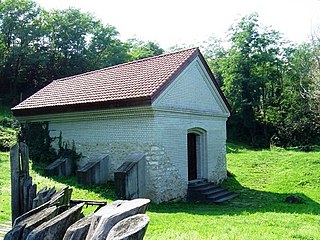Related Research Articles

In Gallo-Roman religion, Rosmerta was a goddess of fertility and abundance, her attributes being those of plenty such as the cornucopia. Rosmerta is attested by statues and by inscriptions. In Gaul she was often depicted with the Roman god Mercury as her consort, but is sometimes found independently.
Borvo or Bormo was an ancient Celtic god of healing springs worshipped in Gaul and Gallaecia. He was sometimes identified with the Graeco-Roman god Apollo, although his cult had preserved a high degree of autonomy during the Roman period.
In Gallo-Roman religion, Damona was a goddess worshipped in Gaul as the consort of Apollo Borvo and of Apollo Moritasgus.

In Celtic polytheism, Sirona was a goddess worshipped predominantly in East Central Gaul and along the Danubian limes. A healing deity, she was associated with healing springs; her attributes were snakes and eggs. She was sometimes depicted with Apollo Grannus or Apollo Borvo. She was particularly worshipped by the Treveri in the Moselle Valley.
In Gallo-Roman religion, Luxovios, Latinized as Luxovius, was the god of the waters of Luxeuil, worshiped in Gaul. He was a consort of Bricta. The thermal spring sanctuary at Luxeuil provided evidence of the worship of other deities, including the sky-horseman who bears a solar wheel, and Sirona, another deity associated with healing springs.
In Gallo-Roman religion, Bricta or Brixta was a Gaulish goddess who was a consort of Luxovius, god of the waters of Luxeuil-les-Bains.

In ancient Celtic religion, Maponos or Maponus is a god of youth known mainly in northern Britain but also in Gaul. In Roman Britain, he was equated with Apollo.

In Celtic mythology, Nantosuelta is the goddess of nature, the earth, fire, and fertility.

Nemetona, or 'she of the sacred grove', is a Celtic goddess with roots in northeastern Gaul. She is thought to have been the eponymous deity of the Germano-Celtic people known as the Nemetes; evidence of her veneration is found in their former territory along the Middle Rhine as well in the Altbachtal sanctuary in present-day Trier, Germany. She is also attested in Bath, England, where an altar to her was dedicated by a man of the Gallic Treveri people.
In Romano-British culture and Germanic polytheism, the Alaisiagae were a quartet of Celtic and Germanic goddesses deifying victory.
Ucuetis is a Gaulish deity who was venerated at Alesia in Burgundy.

Aignay-le-Duc is a commune in the Côte-d'Or department in the Bourgogne-Franche-Comté region of eastern France.
Acionna was a Gallo-Roman water goddess, attested in the Orléanais region.

The Fertőrákos Mithraeum is a temple to the Roman god Mithras at Fertőrákos in Hungary. The temple, follows a typical plan of a narthex followed by the shrine proper that consists of a sunken central nave with podium benches on either side.
Artaha is the name of an ancient goddess that was worshiped in Southern Gaul, in the region of Aquitania. She is a tutelary goddess that is thought to be associated with bears.

In Gallo-Roman religion, Sequana is the goddess of the river Seine, particularly the springs at the source of the Seine. Although the origins of the goddess are Celtic, Sequana was subsequently integrated into a Gallo-Roman regional cult of worship after the Roman conquest of Gaul. The main sites dedicated to her are found in northern Burgundy, especially at the source of the Seine, where archeological excavations have unearthed a temple complex and over a thousand votive offerings.
Sexarbores is a Gallic god known only from inscriptions found in the Hautes-Pyrénées. Like the gods Abellio and Fagus, it could have been a deified tree.

Vesunna is a Celtic goddess worshipped in Roman Gaul. She was likely considered a giver of prosperity, abundance and good fortune, as evidenced by the cornucopia she is depicted carrying in her images.
The Dexivates were a small Gallic tribe dwelling in the southern part of modern Vaucluse, near the present-day village of Cadenet, during the Iron Age and the Roman period.
Rigisamus, also Rigisamos, was a deity in Gaulish and Celtic mythology who, according to the Interpretatio Romana, was connected with Mars.
References
- 1 2 3 4 "Camulus". A Dictionary of Celtic Mythology. Oxford University Press. 2004 [1998].
- ↑ Delamarre 2003, p. 101.
- ↑ ILTG 351; AE 1935, 00064 [In] honor[em d(omus) d(ivinae)] / [3] Martis Cam[uli 3] / [Iucundiniu[s 3] / [Laurenti]um Lavinat[ium
- ↑ CIL 13 3980 : Marti / Camulo / Lellius / Settus / v(otum) [s(olvit)] l(ibens) m(erito)
- ↑ AE 1992, 01244 : Deo Marti Camulo / Verecundus Fructi / v(otum) s(olvit) l(ibens) m(erito)
- ↑ CIL 13 8701 : Marti Camulo / sacrum pro / salute [Neronis] <<Tiberii>> / Claudi Caesaris / [A]ug(usti) Germanici Imp(eratoris) / [c]ives Remi qui / [t]emplum constitu/erunt
- ↑ CIL 13 11818 : Marti / Camulo / sacrum / [ // Fronto / T[3]oni f(ilius) / d(onum) d(edit)
- ↑ CIL 7 1103 : Deo Mar(ti) / Camulo / [m]ilites coh(ortis) [I] / Hamioru[m] / [2]CIV[1]SC[2] / [2]IVI[3]
- ↑ AE 1998, 01100 : Invicto / Mithrae / Marti Camulo / Mercurio / Rosmertae / Q(uintus) Axius Aeli/anus v(ir) e(gregius) / proc(urator) Aug[g](ustorum) / Ioni(us)
- ↑ "Moritix Londiniensium: A Recent Epigraphic Find in London" (PDF). The British Epigraphy Society Newsletter (8): 10–13. Autumn 2002. Retrieved 9 July 2018– via University College London.
- ↑ AE 2002, 882: Num(inibus) Augg(ustorum) / deo Marti Ca/mulo Tiberini/us Celerianus / c(ivis) Bell(ovacus) / moritix / Londiniensi/um / primus [3] / [3]VA[
- ↑ Arthur Cotterell (1997). The Encyclopedia of Mythology: Classical, Celtic, Norse. Anness Publishing Ltd.
- ↑ Crummy, Philip (1997). City of Victory: The story of Colchester - Britain's first Roman town. Colchester Archaeological Trust. ISBN 1 897719 04 3.
- Bibliography
- Delamarre, Xavier (2003). Dictionnaire de la langue gauloise: Une approche linguistique du vieux-celtique continental. Errance. ISBN 9782877723695.

